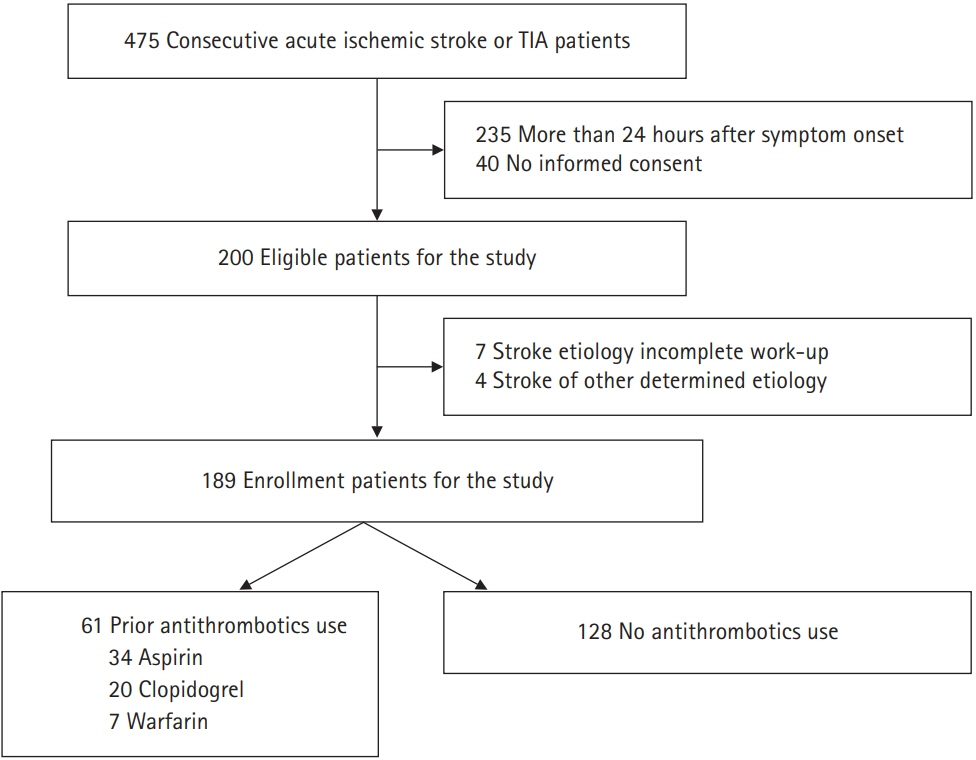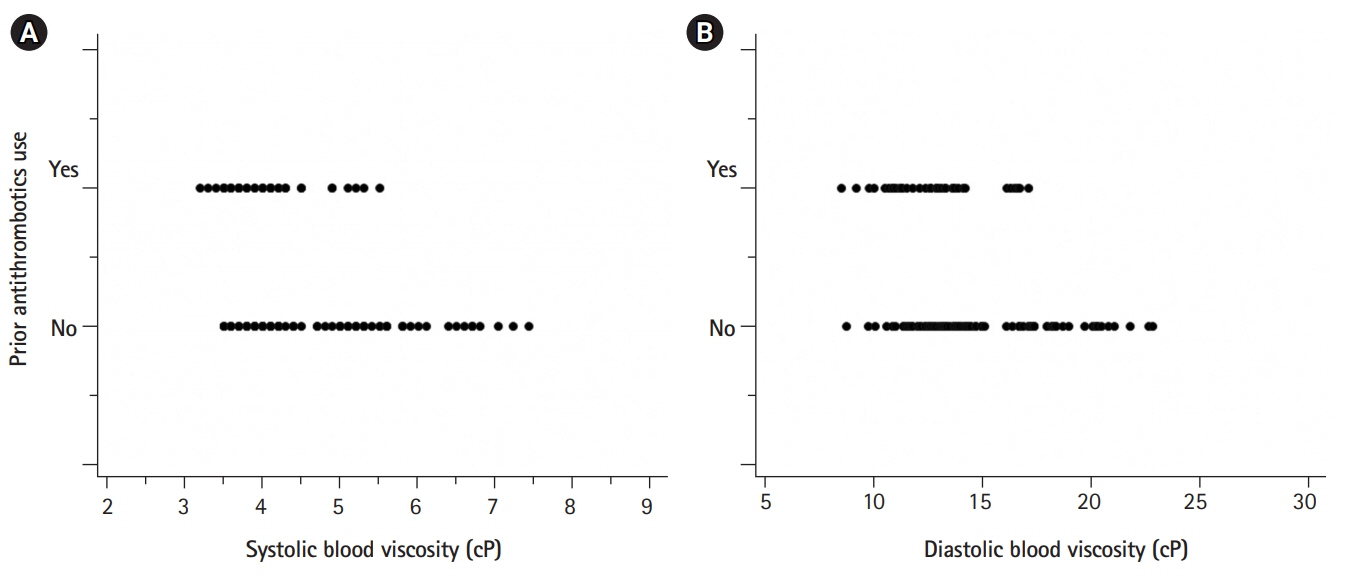J Neurocrit Care.
2019 Dec;12(2):85-91. 10.18700/jnc.190092.
Prior antithrombotic use is significantly associated with decreased blood viscosity within 24 hours of symptom onset in patients with acute ischemic stroke
- Affiliations
-
- 1Department of Neurology, Inje University Sanggye Paik Hospital, Inje University College of Medicine, Seoul, Republic of Korea. swhan@paik.ac.kr
- 2Department of Neurology, Yonsei University College of Medicine, Seoul, Republic of Korea.
- KMID: 2470469
- DOI: http://doi.org/10.18700/jnc.190092
Abstract
- BACKGROUND
Blood viscosity (BV) is the intrinsic resistance of blood to flow and is a measure of blood stickiness. Several clinical and epidemiologic studies have demonstrated an association between BV and the occurrence of major thromboembolic events. Although BV is significantly higher in cases of lacunar or cardioembolic strokes, its relationship with demographic and laboratory parameters during the acute stage of ischemic stroke is unknown. We investigated the relationship between baseline characteristics of acute ischemic stroke and BV within 24 hours of symptom onset in patients with acute ischemic stroke.
METHODS
We enrolled patients aged 40 years or older with documented histories of ischemic stroke or transient ischemic attack within 24 hours of symptom onset. A scanning capillary-tube viscometer was used to assess whole BV.
RESULTS
The mean age was 69.6±12.03 years and 44.4% of the patients were female. Of 189 patients, 68.3% had a history of hypertension; 27%, diabetes; 42.9%, hypercholesterolemia; 3.7%, coronary artery disease; and 18%, stroke. Additionally, 40.7% were current smokers. Sixty-one patients (32.3%) were regularly taking antithrombotics. Multiple linear regression analysis revealed that hematocrit was positively corelated with increased BV and prior antithrombotic use was corelated with decreased BV. Hematocrit-adjusted partial correlation demonstrated that prior antithrombotic use was significantly associated with decreased BV.
CONCLUSION
Prior antithrombotic use is significantly associated with decreased BV within 24 hours of symptom onset in patients with acute ischemic stroke. Our findings indicate that antithrombotic medications may change the hemorheological profile in these patients.
Keyword
MeSH Terms
Figure
Cited by 2 articles
-
Establishing Reference Intervals of Whole Blood Viscosity in a Korean Population Using a Cone-Plate Viscometer
Mikyoung Park, Hanah Kim, Hee-Won Moon, Mina Hur, Yeo-Min Yun
Lab Med Online. 2021;11(3):162-170. doi: 10.47429/lmo.2021.11.3.162.The good genotype for clopidogrel metabolism is associated with decreased blood viscosity in clopidogrel-treated ischemic stroke patients
Joong Hyun Park, Sang Won Han, Hyun-Jeung Yu
J Neurocrit Care. 2020;13(2):93-100. doi: 10.18700/jnc.200023.
Reference
-
1. Furukawa K, Abumiya T, Sakai K, Hirano M, Osanai T, Shichinohe H, et al. Increased blood viscosity in ischemic stroke patients with small artery occlusion measured by an electromagnetic spinning sphere viscometer. J Stroke Cerebrovasc Dis. 2016; 25:2762–9.
Article2. Pop GA, Duncker DJ, Gardien M, Vranckx P, Versluis S, Hasan D, et al. The clinical significance of whole blood viscosity in (cardio)vascular medicine. Neth Heart J. 2002; 10:512–6.3. Song SH, Kim JH, Lee JH, Yun YM, Choi DH, Kim HY. Elevated blood viscosity is associated with cerebral small vessel disease in patients with acute ischemic stroke. BMC Neurol. 2017; 17:20.
Article4. Baskurt OK, Meiselman HJ. Blood rheology and hemodynamics. Semin Thromb Hemost. 2003; 29:435–50.
Article5. Kwaan HC. Role of plasma proteins in whole blood viscosity: a brief clinical review. Clin Hemorheol Microcirc. 2010; 44:167–76.
Article6. Mury P, Faes C, Millon A, Mura M, Renoux C, Skinner S, et al. Higher daily physical activity level is associated with lower RBC aggregation in carotid artery disease patients at high risk of stroke. Front Physiol. 2017; 8:1043.
Article7. Noh HJ, Seo SW, Jeong Y, Park JE, Kim GH, Noh Y, et al. Blood viscosity in subcortical vascular mild cognitive impairment with versus without cerebral amyloid burden. J Stroke Cerebrovasc Dis. 2014; 23:958–66.
Article8. Cowan AQ, Cho DJ, Rosenson RS. Importance of blood rheology in the pathophysiology of atherothrombosis. Cardiovasc Drugs Ther. 2012; 26:339–48.
Article9. Danesh J, Collins R, Peto R, Lowe GD. Haematocrit, viscosity, erythrocyte sedimentation rate: meta-analyses of prospective studies of coronary heart disease. Eur Heart J. 2000; 21:515–20.
Article10. Grotemeyer KC, Kaiser R, Grotemeyer KH, Husstedt IW. Association of elevated plasma viscosity with small vessel occlusion in ischemic cerebral disease. Thromb Res. 2014; 133:96–100.
Article11. Cecchi E, Marcucci R, Poli D, Antonucci E, Abbate R, Gensini GF, et al. Hyperviscosity as a possible risk factor for cerebral ischemic complications in atrial fibrillation patients. Am J Cardiol. 2006; 97:1745–8.
Article12. Fisher M, Meiselman HJ. Hemorheological factors in cerebral ischemia. Stroke. 1991; 22:1164–9.
Article13. Kennedy J, Hill MD, Ryckborst KJ, Eliasziw M, Demchuk AM, Buchan AM, et al. Fast assessment of stroke and transient ischaemic attack to prevent early recurrence (FASTER): a randomised controlled pilot trial. Lancet Neurol. 2007; 6:961–9.
Article14. Ernst E, Matrai A, Kollar L. Placebo-controlled, double-blind study of haemodilution in peripheral arterial disease. Lancet. 1987; 1:1449–51.
Article15. Papaioannou TG, Stefanadis C. Vascular wall shear stress: basic principles and methods. Hellenic J Cardiol. 2005; 46:9–15.16. Jung LY, Lee SR, Jung JM, Kim YS, Lee SH, Rhee KS, et al. Rosuvastatin reduces blood viscosity in patients with acute coronary syndrome. Korean Circ J. 2016; 46:147–53.
Article17. Lee CH, Jung KH, Cho DJ, Jeong SK. Effect of warfarin versus aspirin on blood viscosity in cardioembolic stroke with atrial fibrillation: a prospective clinical trial. BMC Neurol. 2019; 19:82.
Article18. Rosenson RS. Treatment with aspirin and dipyridamole is more effective than aspirin in reducing low shear blood viscosity. Microcirculation. 2008; 15:615–20.
Article19. Stäubli M, Reinhart W, Straub PW. Blood viscosity and red cell deformability after aspirin in vivo. A double-blind controlled trial. Atherosclerosis. 1982; 41:167–70.20. Hitosugi M, Niwa M, Takatsu A. Changes in blood viscosity by heparin and argatroban. Thromb Res. 2001; 104:371–4.
Article21. Ciuffetti G, Lombardini R, Pirro M, Lupattelli G, Mannarino E. Clopidogrel: hemorheological effects in subjects with subclinical atherosclerosis. Clin Hemorheol Microcirc. 2001; 25:31–9.22. Dawson DL, Zheng Q, Worthy SA, Charles B, Bradley DV Jr. Failure of pentoxifylline or cilostazol to improve blood and plasma viscosity, fibrinogen, and erythrocyte deformability in claudication. Angiology. 2002; 53:509–20.
Article23. Thomas DJ, Marshall J, Russell RW, Wetherley-Mein G, du Boulay GH, Pearson TC, et al. Effect of haematocrit on cerebral blood-flow in man. Lancet. 1977; 2:941–3.
- Full Text Links
- Actions
-
Cited
- CITED
-
- Close
- Share
- Similar articles
-
- Review of Updated Guidelines and Evidence for Antithrombotic Therapy in Acute Ischemic Stroke
- Association of Cerebral Artery Stenosis with Blood Viscosity in Patients with Transient Ischemic Attack
- The good genotype for clopidogrel metabolism is associated with decreased blood viscosity in clopidogrel-treated ischemic stroke patients
- Treatment for Patients with Acute Ischemic Stroke Presenting beyond Six Hours of Ischemic Symptom Onset : Effectiveness of Intravenous Direct Thrombin Inhibitor, Argatroban
- Factors related to Blood Pressure Reduction during Acute Period of Ischemic Stroke



